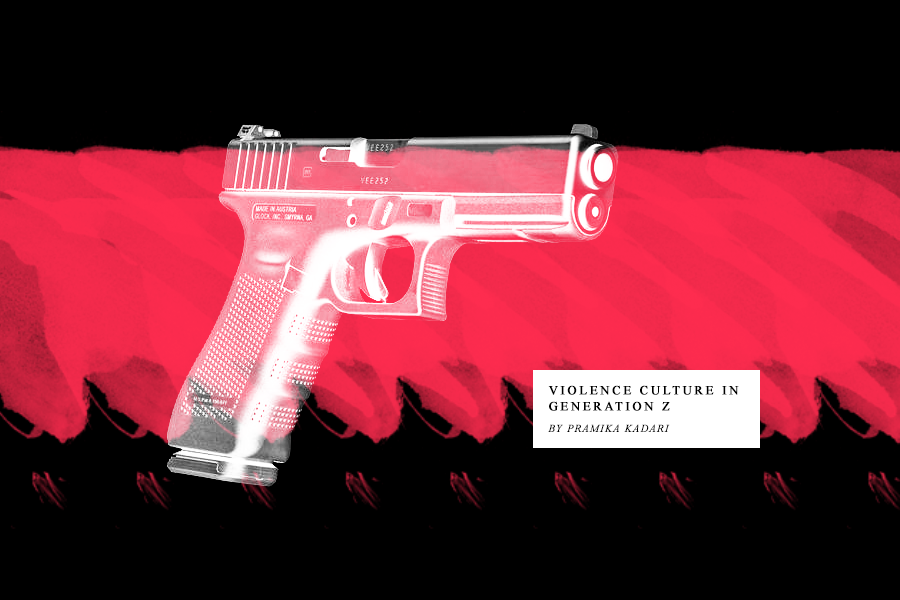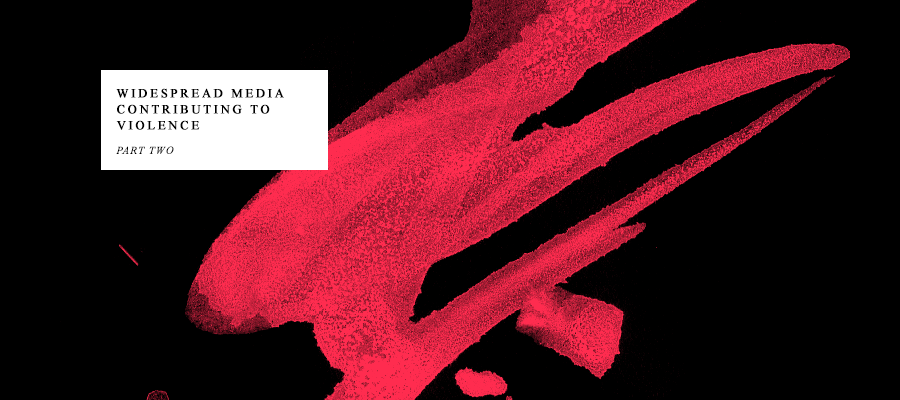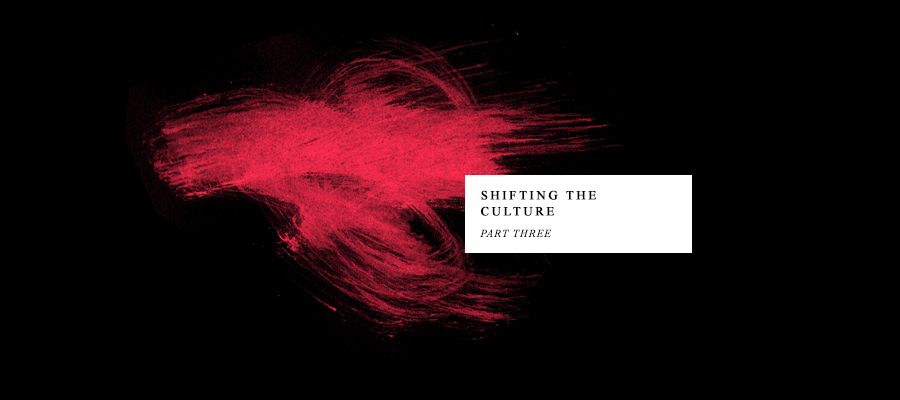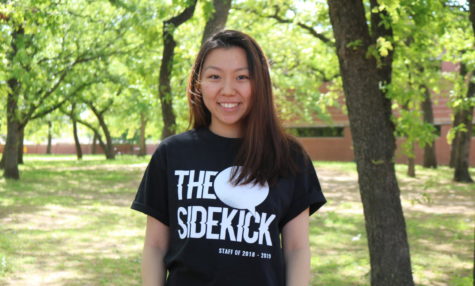Pervasive violence damaging Generation Z culture
Technology, mental illness, widespread media contributing to daily bloodshed
January 11, 2019

It seems like everyday, the world is hit with another act of violence. News channels greet viewers with tragedies regularly – someone has killed themselves, someone has brutally murdered another, someone has shot up a school or a movie theater.
To older generations, this scale of violence in our everyday lives is something never experienced for such a prolonged period of time. To Generation Z, the generation from the late 1990’s to early 2000’s, growing up in a post 9/11 world, this is just the evening news.
Why?

Throughout the last two decades, a slew of technological advances have taken the world by storm, transforming humanity. Smartphones, electric cars and instant streaming services such as Netflix are only a few of the numerous recent innovations.
As a result, most people’s face-to-face interaction with others has decreased drastically. In early 2017, the average American’s eyes were glued to a screen for over 10 hours a day, according to CNN.
“The less interactions we have with actual human beings, there is likely to be an increase in violence,” Coppell High School AP psychology teacher Kristia Leyendecker said. “Social media has allowed us to dehumanize each other. A text sentence versus an actual sentence – the tone can be completely different. [More communication] based off texting and emailing could eventually contribute to more violence. Because how often is it that a kid gets a text from one friend and gets upset because they took it the wrong way? We need to adapt to our new technologies in such a way that requires us to remain interacting in a face-to-face manner.”
In 1995, only 0.4 percent of the world’s population used the Internet, but by 2017 that increased to more than 54.5 percent. The World Wide Web is home to millions of websites, many reporting news from around the world. Because popular news agencies such as The New York Times, CNN and Fox News all have mobile apps, when something terrible happens halfway across the world, many American readers will know within seconds.
“Our 24-hour, seven-days-a-week, nonstop access to social media and news is increasing mental health issues,” Leyendecker said, “It’s increasing violence, it’s increasing relationship issues, it’s increasing a lack of verbal communication and interaction. It’s too easy to sit back and flip through Twitter and go through news sites and make comments, and soon you look up and it’s been two hours, and you haven’t talked to another human being, you haven’t moved, [and] you’re angry because you’ve been reading news reports.”
The Digital Age inevitably comes with a sense of anonymity – that anonymity is a double-edged sword. The online disinhibition effect describes the tendency to treat people differently behind a screen than in person, and is separated into two varieties: benign disinhibition and toxic disinhibition. While the former is embodied by increased emotional vulnerability or kindness online, the latter manifests itself through vulgar disrespect or enmity.

In recent years, with the rise of technology, internet and social media usage has soared. Increasing virtual interaction has been a factor in Generation Z’s culture of violence.
“When people have a sense of anonymity, they’re more likely to treat others more poorly,” CHS AP psychology teacher Jared Stansel said. “If technology is going to continue to develop, and we’re going to continue to rely on social media, there will be a lot more miscommunication which leads to misunderstanding, which leads to more polarization and feelings of isolation, and that leads to more mental health problems.”
According to psychologist Pamela D. Garcy, eventually those mental health problems will lead to more violence. In addition to technology, mental health issues are one of the biggest factors in Generation Z’s culture of violence.
“When people are mentally healthy, they’re less likely to resort to violence as a way to solve their problems,” Garcy said. “The less healthy someone is, the less likely they’re able to cope effectively with their problems. They’re less effective in coping with stress, and less effective in communicating, and less effective in their interpersonal relationships.”
Garcy said that ineffectiveness, in combination with isolation from support or proper treatment, can lead to poor decision-making skills, as well as heightened impulsiveness.
Because mental health issues — especially more common illnesses such as depression and anxiety — are becoming less stigmatized than they have been in the past, more teens are opening up about them among each other, according to Coppell High School senior Alex Goodwin.
“When you’re around people who have mental health issues, you might be sad for a couple days because of a break up and then think ‘oh, I’m depressed’,” Goodwin said. “But you may not actually be depressed, you may just have confusing emotions and may feel sad. And I think its a placebo effect. Because of social media, there’s so much negativity and sadness.”
Today’s citizens can hold millions of websites, a plethora of TV shows and thousands of text messages in the palm of their hands. According to Leyendecker, there is not enough opportunity to be truly bored.
“Kids in this generation don’t have any dead time,” CHS AP Psychology teacher Eric Walker said. “There’s a certain amount of time your brain needs to decompress, not be exposed and bombarded. Being bored is actually a good thing for brain health. It gives your brain the ability to reset, and that downtime is important.”
That lack of opportunity to be bored is not only medically important, but also emotionally.
“The other part about having dead time is an increase in creativity,” Leyendecker said. “We don’t give ourselves time to daydream. To sit there and ponder different things. Part of that then also affects people’s ability to be hopeful. Because if you don’t allow yourself to dream, then we get driven on the very things everyone says we should be, versus thinking about what we really want. That then leads to unhappiness, and the road continues to go down, [possibly to violence].”
With the rise of technology, social media has become one of the most prevalent uses of the internet. Seventy-seven percent of Americans use social media, and globally the average person uses social media for more than two hours each day. Over a lifetime, that daily usage could add up to over five years total.
Many users, especially teeangers, spend hours on a picture for Instagram, Snapchat or similar platforms. Numerous editing apps are available and regularly used; often, users take an abundance of photos and with the help of their friends, select only the most flattering one to show the world.
“[Social media] conditions you to look for immediate gratification,” Stansel said. “It has a lot to do with dopamine in the brain. They only want people to see how well-liked they are. There’s this false reality. No one feels like they’re truly known. And if you don’t feel like you’re truly known, that means the world can be very isolating. And you feel like you’re stranded or stuck by yourself. This plays a big role in why rates of depression, rates of stress and anxiety are on the rise.”
Social media is built on numbers. Who has more followers, more likes, more comments? Users often time their posts perfectly to maximize the number of likes they will receive; many accept follow requests from people they do not know in order to increase their follower count, and a few even buy followers for the same reason. In school, students face similar stresses through SAT scores and GPA.
“This whole thing of numbers is hurting people’s mental health,” Goodwin said. “With the numbers at school, you want to escape from it and you go to social media but it’s the same thing with numbers again. People want attention, and attention isn’t inherently bad; we’re human, we all want attention. But it’s like, ‘I need attention or I don’t feel worthy enough.’”
According to USA Today, 24 studies from around the globe found that kids and teenagers playing games such as Call of Duty and Manhunt were often punished for fighting with others.
“In gaming technology, we can get desentensized because we are playing games that include a lot of violence, and it makes it very normalized, and distances us from the effects of the violence,” Garcy said. “On a game, we’re thinking about winning the game, but not necessarily what it would feel like for the person to get shot.”

A multitude of films, television shows and games in today’s world are littered with excessive violence. After the Netflix show 13 Reasons Why premiered in 2017, although it received praise, it was also widely resented due to its problematic aspects; one of the most controversial scenes was a bloody depiction of the main character’s suicide, which was correlated with an increase in suicide attempts.
Pervasive reporting and widespread access to news also leads to copycat crimes – acts of violence modeled after previous ones. The phrase originated after murderers began copying killer Jack The Ripper in the late 1880s, but the term unfortunately still applies today.

“Every time there’s something awful that happens, we hear people come out and say ‘we need to do this to stop it,’” Leyendecker said. “There’s not one solution. It is multifaceted, there is not a quick fix.”
But that does not mean there is nothing people can do to reduce the chance of another mass shooting, another suicide, another murder. In Goodwin’s opinion, society needs to further destigmatize all varieties of mental illnesses – to make those struggling feel truly comfortable opening up to professionals and adults who can actually aid them, in order to receive treatment before resulting bursts of violence.
“It all starts with the foundations of kids, with the school and with the parents,” Goodwin said. “A lot of it is accepting it’s OK to feel different things, you don’t have to be happy all the time. That doesn’t mean you should not seek help but… once people realize it is okay and they can get help, it’ll be better.”
Furthermore, according to Leyendecker, people need to be more aware of symptoms and doctors need to screen for those symptoms from an early age, in order to help the patient as much as possible throughout their life. Many Americans schedule regular appointments to check up on their physical health, but the same rarely happens for mental health.
On the technology side, people need to educate themselves on the dangers of social media and increasing digital reliance, according to Stansel.
“I don’t have a cell phone, I refuse to,” Stansel said. “I also don’t use Facebook. I’m not constantly checking the news on my phone, I’m not looking for immediate gratification on Facebook, I have real conversations with my students, with my colleagues. I get to know them as human beings, as individuals. That’s what people need to do in order to be more peaceful.”
People have tremendous control over the future of our world – and if they want to switch on the news a year from now and see happiness instead of devastation, the necessary actions that must be taken can begin now.
“The individuals within society have to change and then society itself can change,” Stansel said.













Pramika Kadari • Jan 17, 2019 at 11:12 pm
Thanks Anthony, I’m glad to have surprised you.
Anthony Cesario • Jan 17, 2019 at 2:14 pm
Great story Pramika! I found some of these statistics quite surprising.
Charlotte Vanyo • Jan 14, 2019 at 9:16 pm
What an important story. You did an excellent job Pramika!
Pramika Kadari • Jan 16, 2019 at 9:25 pm
Thanks!